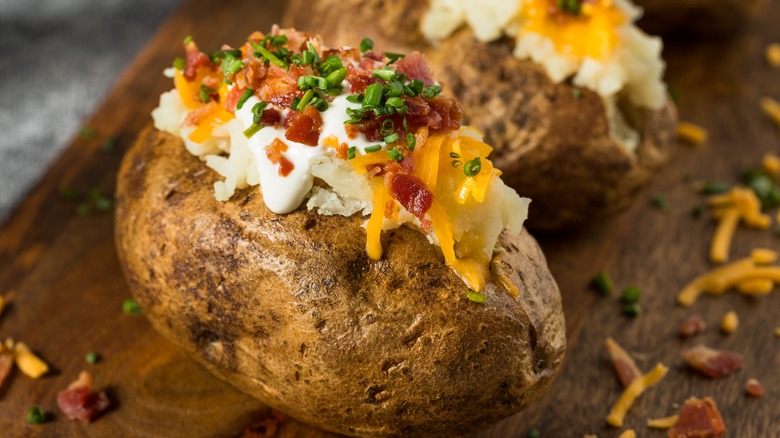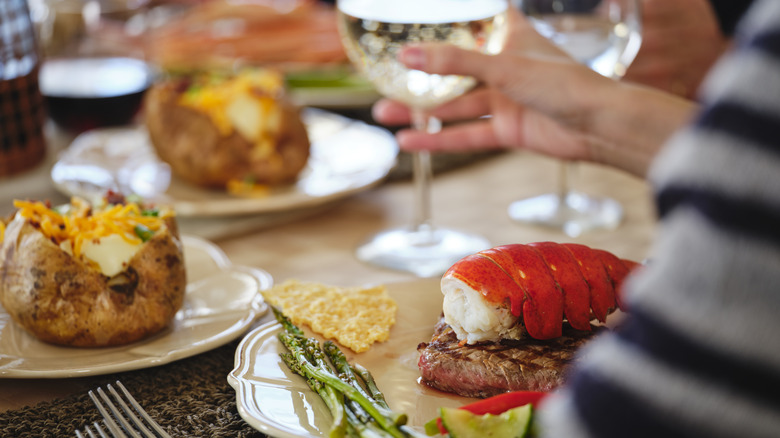Why Baked Potatoes Always Taste So Much Better At A Restaurant
Potatoes are a global staple food, and it's easy to see why. Not only are they packed with sustaining carbohydrates and nutrients like vitamin C and potassium, but they are one arguably of the most craveable foods on the planet. And while French fries may seem to get the majority of the fanfare, the humble baked potato — when done right — can upstage just about any preparation.
Yet, for as simple as this food may seem, somehow the same combination of ingredients (spud plus fat plus salt, in its most basic iteration), always seem to be superior in a restaurant setting. They are delivered to the table fluffy and tender on the inside, with a crisp, flavorful skin that is impossible to resist.
Once you understand why restaurants represent the pinnacle of baked potato perfection, however, you can easily and reliably replicate that right at home. It really comes down to two major pieces of advice: Ditch the foil and embrace the fat.
Why these two factors produce better baked potatoes
For generations, home cooks have been following a similar protocol for baked potatoes. Wrap them tightly in aluminum foil and toss them in the oven. Here's the problem: As your potato cooks, its moisture becomes trapped in this tiny tin package, and instead of evaporating, it stays in contact with your potato skin. This means that instead of achieving that delicious, crispy crust, you wind up with soft and soggy peels that are, well, unappealing.
Restaurant chefs know that you're robbing yourself of the beautiful contrast a restaurant baked potato offers by sticking to this old school method. Instead, these establishments liberate their spuds from the foil and give them a rub down with cooking fat. This method is responsible for that satisfying crackly texture that is such a perfect contrast to the pillowy flesh within. If you've ever baked a potato and found the skin to be too tough to enjoy, or have an off-putting flavor, it may have resulted from no cooking fat being used on the skin. Restaurants know that this step also helps ensure a tender, tasty exterior that diners will remember long after leaving their table.
Replicating restaurant baked potatoes
With these restaurant secrets in mind, it's easy to create your own prized baked potato right at home. Omitting the foil is as simple as forgetting that it was ever a part of your process. Selecting the fat with which you'll bake the potato is the next step. You may automatically associate baked potatoes with butter, but oil is the superior option for the baking process. While some cooks do use butter, and say it can contribute a familiar creamy flavor, other sources suggest that the water content that comes along with it will prevent your potato's skin from becoming crisp.
Instead, opt for a fruity, fragrant olive oil, or a less assertive selection like canola or vegetable. Whichever you choose, just be sure to provide your potato with a generous coating of fat using a pastry brush (or a paper towel in a pinch) before baking if you want to serve up a crispy-skinned masterpiece.
In general, restaurants like steakhouses always have better tasting potatoes for other reasons, too, like sticking to starchy russet or Yukon Gold potatoes. They also coat potatoes with salt after they've been oiled; this helps draw out moisture, which — once evaporated — helps promote that contrast of fluffy meets crisp. Whether you prefer classic oven-baked potatoes to serve with the best grilled steak recipe, or like to load it up with cheese and bacon, sour cream and herbs, restaurant-style potatoes will always be in fashion.


